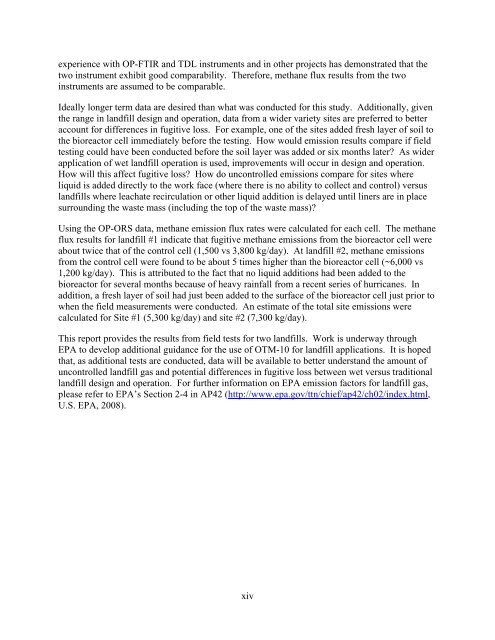Quantifying Uncontrolled Landfill Gas Emissions from Two Florida ...
Quantifying Uncontrolled Landfill Gas Emissions from Two Florida ...
Quantifying Uncontrolled Landfill Gas Emissions from Two Florida ...
You also want an ePaper? Increase the reach of your titles
YUMPU automatically turns print PDFs into web optimized ePapers that Google loves.
experience with OP-FTIR and TDL instruments and in other projects has demonstrated that the<br />
two instrument exhibit good comparability. Therefore, methane flux results <strong>from</strong> the two<br />
instruments are assumed to be comparable.<br />
Ideally longer term data are desired than what was conducted for this study. Additionally, given<br />
the range in landfill design and operation, data <strong>from</strong> a wider variety sites are preferred to better<br />
account for differences in fugitive loss. For example, one of the sites added fresh layer of soil to<br />
the bioreactor cell immediately before the testing. How would emission results compare if field<br />
testing could have been conducted before the soil layer was added or six months later? As wider<br />
application of wet landfill operation is used, improvements will occur in design and operation.<br />
How will this affect fugitive loss? How do uncontrolled emissions compare for sites where<br />
liquid is added directly to the work face (where there is no ability to collect and control) versus<br />
landfills where leachate recirculation or other liquid addition is delayed until liners are in place<br />
surrounding the waste mass (including the top of the waste mass)?<br />
Using the OP-ORS data, methane emission flux rates were calculated for each cell. The methane<br />
flux results for landfill #1 indicate that fugitive methane emissions <strong>from</strong> the bioreactor cell were<br />
about twice that of the control cell (1,500 vs 3,800 kg/day). At landfill #2, methane emissions<br />
<strong>from</strong> the control cell were found to be about 5 times higher than the bioreactor cell (~6,000 vs<br />
1,200 kg/day). This is attributed to the fact that no liquid additions had been added to the<br />
bioreactor for several months because of heavy rainfall <strong>from</strong> a recent series of hurricanes. In<br />
addition, a fresh layer of soil had just been added to the surface of the bioreactor cell just prior to<br />
when the field measurements were conducted. An estimate of the total site emissions were<br />
calculated for Site #1 (5,300 kg/day) and site #2 (7,300 kg/day).<br />
This report provides the results <strong>from</strong> field tests for two landfills. Work is underway through<br />
EPA to develop additional guidance for the use of OTM-10 for landfill applications. It is hoped<br />
that, as additional tests are conducted, data will be available to better understand the amount of<br />
uncontrolled landfill gas and potential differences in fugitive loss between wet versus traditional<br />
landfill design and operation. For further information on EPA emission factors for landfill gas,<br />
please refer to EPA’s Section 2-4 in AP42 (http://www.epa.gov/ttn/chief/ap42/ch02/index.html,<br />
U.S. EPA, 2008).<br />
xiv















